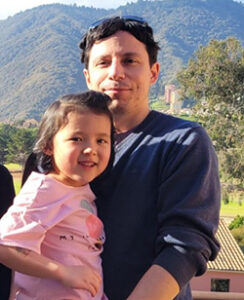 Gabriel Piña is a research scientist in youth development at Child Trends who conducts quantitative analyses to research youth and early childhood issues. Gabriel serves as the quantitative lead on several large-scale projects and is one of the primary analysts on the Social Genome Model, a microsimulation model.
Gabriel Piña is a research scientist in youth development at Child Trends who conducts quantitative analyses to research youth and early childhood issues. Gabriel serves as the quantitative lead on several large-scale projects and is one of the primary analysts on the Social Genome Model, a microsimulation model.
We talked with him to learn about his research, both at Child Trends and earlier in his career, and to find out more about his life outside of work.
Can you tell us about your primary research interest(s)?
My primary research interest is in program evaluation and policy analysis research—understanding how public programs and policies work and what their impacts are. I’m usually studying programs that address poverty and its consequences for families, children, and youth, with a more quantitative focus.
What sparked your interest in program evaluation and policy analysis?
I grew up in Chile during a dictatorship that later became a democracy; during my country’s political transformation, there was a lot of discussion about how to design and implement new policies and programs. Also, both of my parents are journalists, so conversations about policy and politics were very common at the dinner table when I was young. That led me to study economics, but I always felt that the field provided an incomplete view about policy—focusing too much on efficiency and markets and too little on good policy. One day, I read that a school in the United States had a Master of Public Policy (MPP) degree: I immediately knew that I wanted to study that, so I started to save money and study English in the evenings. I ultimately attended the University of Minnesota for my MPP before graduating from Indiana University with a PhD in public affairs.
One of your current research projects is on the Social Genome Model. Can you tell us a little about the SGM and why it’s such a valuable tool?
The Social Genome Model (SGM) is a microsimulation model developed by the Brookings Institution, Child Trends, and the Urban Institute. The SGM allows us to simulate changes in the lives of children and examine how these changes can accumulate into long-term benefits. The value of this model is that it fills some gaps we usually find in most evaluation work: For example, evaluations usually focus on one or two outcomes and don’t follow participants for a long time. The SGM, by contrast, allows us to forecast the potential impacts of programs on a variety of measures, so it can be a useful decision-making tool for national, state, and local decision makers.
What books or journal articles have most influenced you?
There are too many books and resources about poverty to cite just a few, but I’d say that experiences—more than books—shaped my interests, including participating in a homeless count in Minnesota. On a cold day in January, I interviewed people staying in homeless shelters. I was shocked that a rich country like the United States was not able to provide more resources for people going through extenuating circumstances. Later, during my PhD, I read books such as Alberto Alesina’s Fighting Poverty in the US and Europe: A World of Difference, which helped me understand how institutions, racial issues, and beliefs about the nature of poverty in the United States have constrained financial support for programs addressing these problems.
What are your hobbies or interests outside of research?
I enjoy playing tennis and reading. Both tennis courts and libraries are almost everywhere, and are free to access in the United States. It was hard to believe when I first moved here!
To wrap up, can you tell us a fun or interesting fact about yourself or your family?
I only speak in Spanish with my daughter, and my wife only speaks Chinese with her. She is now trilingual, so I think she is the only one who fully understands what’s going on at home.
© Copyright 2025 ChildTrendsPrivacy Statement
Newsletter SignupLinkedInYouTubeBlueskyInstagram
